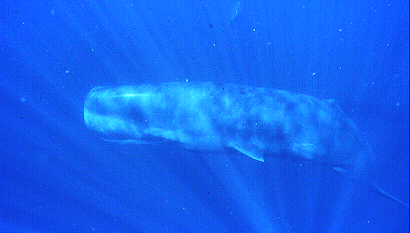Sperm Whale

Sperm whales are sociable animals that live in groups. The group structure varies according to the age and sex of the whale. Males live apart from females. The females form groups together with their young, numbering from five to 30 animals. There are also smaller bachelor pods of young, non-breeding whales, as well as much larger groups, consisting of many females, young, and a dominant, sexually mature bull. The whales, dive, swim, feed, and sleep together within their group. They also have a language of sonar clicks which they use to communicate. In summer, the whales migrate to feed in the Arctic and Antarctic.
The sperm whale has been ruthlessly hunted by man for centuries, and continues to be persecuted. Whalers have taken advantage of the whale's protective instinct, whereby all members of a group will surround an injured animal in what is known as the Marguerite formation. Whalers harpoon a single sperm whale to attract other whales who come to its rescue and then kill them as well. Man hunts the sperm whale for food, and for the oil its blubber provides. It is also hunted for the spermaceti wax found in its head and for a substance called ambergris, found in its intestines.
Groups of sperm whales begin their migration to the equator from the Arctic and Antarctic every fall for the winter breeding season. The bulls attempt to form groups of up to 30 adult females. Fierce fights between males for females are not uncommon. Once the group is established, the bull mates with any female not already pregnant or with young. After mating, the female gives birth 14-16 months later. The other females protect her while she is giving birth, and then help the calf to the surface to take its first breath. The mother feeds her calf with fat-rich milk for as long as two years, by which time it has grown to a length of about 23 feet.
The sperm whale feeds on bottom-dwelling organisms, such as squid. Sometimes, giant squid put up such a struggle that scars are made on the whale's head by its tentacles. Scientists are not certain how the sperm whale catches its prey, but it is believed that the whale stuns it with very loud sound waves. The sperm whale will also eat snapper, lobster, and even shark. It swallows its prey whole. An adult whale will eat up to 1 ton of food every day.
Sperm whales live in the oceans of the world in two groups--one migrates north of the equator to the Arctic and the other south of the equator to the Antarctic. Despite protection from the International Whaling Commission, numbers have dropped from 170,000 males and slightly fewer females to only 71,000 males and 125,000 females.
We got our information from the "Wildlife Fact File".
Front Page
